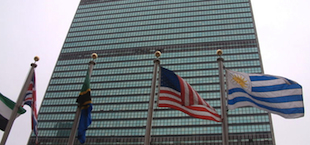United Nations headquarters. Photo: Javier Carbajal Wikimedia Commons
[Letter From New York]
As the implementation of the 2030 Agenda for Sustainable Development or Sustainable Development Goals (SDGs) gathers momentum and the Agenda is up for review by world leaders at the United Nations General Assembly later this month, let us remind ourselves of what was in the mind of the framers of the Agenda so that we don’t lose the central message between now and 2030 when the Agenda comes to an end.
Through formal debates, weekend retreats and side event discussions, the framers of the Agenda were reminded of the successes and shortcomings of economic and social development since World War II. Issues such as the role of the state in the development process, growth without development or trickle down, one dimensional or silo approach to development and top-down domination of program design, implementation, monitoring and evaluation occupied center stage. For easy reference, let us briefly examine these issues one by one.
During the implementation of structural adjustment programs between 1980 and the end of the first decade in the 21st century, the role of the state was significantly reduced largely to areas of no interest to the private sector. The government was considered the problem, not the solution to development problems like economic stagnation, high inflation, high unemployment and high external debt. However, towards the end of the structural adjustment period, it had become clear that the state had a strategic role to play in the development process including addressing the imperfections of market forces and laissez faire practices. The strategic role of the state was therefore restored in concert with the private sector, civil society organizations, community-based organizations and in a spirit of partnerships.
The framers recognized that economic growth is about people, not things. The benefits of growth had not trickled down to the masses, leading to unacceptable inequalities, high levels of poverty and other ills including environmental degradation and labor exploitation. The 2030 Agenda adopted corrective steps that integrate economic growth, social development, environmental protection and the rule of law dimensions. This vital integrative aspect must not be lost sight of during the implementation process.
The development process had largely adopted a one-dimensional or silo approach such as focusing on industrialization at the expense of agriculture or capital-intensive techniques at the expense of labor-intensive priorities or national security at the expense of sustainable economic and social development. This shortcoming was corrected.
The Agenda has stressed that no sector of the economy or society should be excluded from program formulation, implementation, monitoring and evaluation. Therefore, political, civil, security, economic, rural and urban, top-down and bottom-up and other social and cultural sectors must be treated together in an integrated, indivisible and interdependent or mutually-reinforcing manner so that no sector of human endeavor or member of society is left behind.
As you can see, the changes that were incorporated into the 2030 Agenda constitute a new development paradigm. The successful implementation of this paradigm will therefore require transformed institutions, methods and above all mindsets.
This is a tall order that calls for sufficient political will of those involved so that the Agenda produces the desired results, particularly the overarching goal of poverty eradication in all its forms and dimensions.
The good news is that the world has enough resources and technology. Not least, population growth is slowing down.
Kashambuzi is an international economist and human rights activist.
New York City, USA
September 2019

